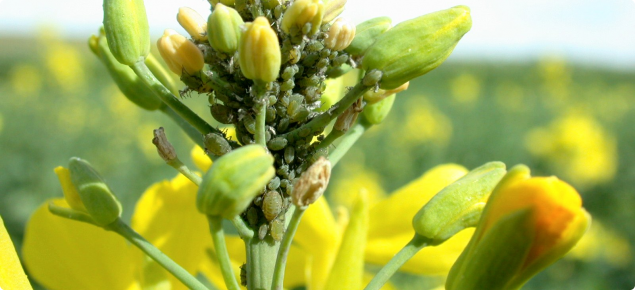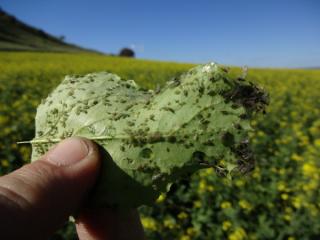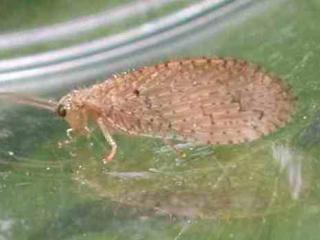Description
Three aphid species commonly attack canola in Western Australia:
- Turnip aphid
- Cabbage aphid
- Green peach aphid
Distinguishing features of the three species of aphids found attacking canola in WA
| - | Turnip aphid | Cabbage aphid | Green peach aphid |
|---|---|---|---|
| Length of adult (mm) | 1.4-2.4 | 1.6-2.8 | 1.2-2.3 |
| Abdomen colour | Greyish to mid green | Greyish to mid green | Shiny yellow to mid green to pink or red |
| Other features | Body often has a light waxy covering, dark bars on abdomen | Body covered with a dense white mealy wax | Black patch on abdomen of winged adults. Wingless forms uniform in colour |
| Colony habit | Dense colonies, usually around growing tips and flowering spikes | Dense colonies usually seen on flowering spikes | Mostly found on the underside of lower leaves. Sparse colonies may occur with turnip or cabbage aphids |
| Abundance on canola | Usually common and abundant; depending on season | Common and abundant on canola | Common but seldom builds up to large colonies |
| Alternative hosts | Wild radish, wild turnip and self sown canola | Wild radish, wild turnip and self sown canola | Wild radish, wild turnip and self sown canola, lupins, capeweed |
How crop infestations start
Winged aphids fly into the crop from autumn weeds. Winged aphids that migrate to the crop give rise to colonies consisting of mostly wingless aphids. Aphids that arrive in crops in autumn and persist in low numbers over winter may lead to large, damaging populations that peak in late winter and early spring.
Cold and wet conditions during winter tend to suppress aphid population development. Turnip and cabbage aphids are rarely seen together on the same plant, but both form characteristically dense clusters on the terminal flowering spikes and are generally the most damaging and common species encountered in Western Australian crops.
Careful monitoring for crop pests will often reveal aphids hidden on stems amongst the buds and flowering heads of canola. The green peach aphid is often found in seedling crops; on established crops it prefers to feed on the undersides of older canola leaves where it causes little or no damage.
Feeding damage
Large populations of aphids that may develop in late winter and early spring cause damage by feeding on the growing shoot tips, causing wilting, flower abortion and reduced pod set.
If aphid populations are very large, the sticky honeydew which aphids exudate can lead to a black mould growth. This mould rarely occurs in canola crops, but if it is present it can reduce the plants’ ability to photosynthesize and decrease plant vigour.
Results of feeding damage trials
Significant yield losses of up to 33% were recorded in WA in a replicated field trial in 2003. Growing canola in low rainfall areas where drought stress is more likely, coupled with the release of cultivars more susceptible to aphid colonisation, have increased the risk of aphid feeding damage and yield losses to canola in these areas.
Trials have shown it is feeding damage from cabbage aphid, which forms colonies on the flowering spikes of canola, which causes yield loss. Green peach aphid colonisation of flowering canola was not found to cause yield loss, however, colonisation of canola at the seedling stage did lead to yield loss. Refer to 'See Also' section for results.
Aphid populations develop more rapidly on plants suffering from moderate drought stress compared to healthy, stress free plants. These stressed plants being targeted by aphids are less able to compensate for aphid feeding damage than healthy plants.
Yield loss from viruses
Aphids can also transmit turnip yellows virus (TuYV) which is persistently transmitted by aphids and green peach aphids are the most important vector.
Most yield loss occurs when aphids transfer the virus very early in the life of the crop which can lead to stunting and obvious reddening of plants. Studies by WA plant virologists of the relationship between virus infection and yield losses in canola have shown that a combination of TuYV and green peach aphids can cause yield losses of up to 50% in canola.
Monitoring for aphids
Canola is most sensitive to aphid damage during bud formation through to late flowering.
Crops at this stage should be checked regularly for aphids in case numbers escalate enough to cause economic damage to the crop. Start monitoring from late winter and continue through spring.
Aphid distribution can be patchy. Check at least five points of the paddock, and look for aphids on a minimum of 20 plants at each point. Check plants and count the number of flowering spikes infested with aphids.
Also look for the beneficials
Beneficials include predators (ladybirds, hover flies and lacewing) and parasitic wasps. These are a common form of aphid control during the warmer days of spring and when low to moderate numbers of aphids are present but they have less impact on heavy infestations of aphids.
What predators look like
- Hoverfly larvae feed on aphids
- Hoverfly adults are more likely to be seen in crops
- Lacewing larvae and adults feed on aphids
What parasitic wasps look like
These are wasp species, which sting the aphids and lay an egg inside. The larvae hatches and slowly consumes the aphid, eventually killing it. The parasite larva creates a ‘mummy’ by spinning a cocoon inside the aphid, then pupates and soon emerges as an adult wasp. The presence of bloated aphids with a pale gold or bronze sheen indicates parasite activity in your canola crop.
Threshold for aphids
If more than 20% of plants are infested with colonies of aphids, control measures should be considered to avoid yield losses.
Factors that increase the risk of economic yield losses are poor finishing rains or crops already under some degree of drought stress.
Encourage beneficials
Predators and parasites should be encouraged as a natural way of suppressing aphid numbers. This can be achieved by using ‘softer’ chemicals (such as pirimicarb) which are aphid-specific and less harmful to other insects.
Cultural controls
Implement early control of weeds such as wild radish and wild turnip on your property to prevent aphid build up. Sow crops early to enable plants to begin flowering before aphid numbers peak.
Chemical control
Pirimicarb and sulfoxaflor are currently registered for aphid control in canola crops in this state. Check with the Australian Pesticides and Veterinary Medicines Authority (APVMA) for any off-label permits each growing season.
Green peach aphids and resistance
Large numbers of green peach aphids occasionally occur on young, vegetative canola, which may require treatment; some of these populations are resistant to some chemicals.
Synthetic pyrethroids (SPs) and some organophosphates (OPs) have given poor kill results when applied to aphid-infested canola. Often the crop needs to be resprayed after SP application, which achieves less than optimum kill rates. Avoid using SPs for this reason and also because this chemical group selects for insecticide resistance and kills non-target organisms including beneficial insects. For more information refer to Grains Research and Development Corporation's Green peach aphid management strategy.
Acknowledgements
Grains Research and Development Corporation for provided funding for aphid research trials.








